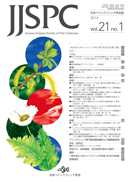
- |<
- <
- 1
- >
- >|
-
Ayano OIWA, Daichi KAWAMURA, Yoshiyasu HATTANMARU, Mizuyuki NAKAMURA, ...2023Volume 30Issue 3 Pages 37-41
Published: March 25, 2023
Released on J-STAGE: March 25, 2023
JOURNAL FREE ACCESS FULL-TEXT HTMLGlossopharyngeal nerve blockade involves a high risk of erroneous puncture of nearby blood vessels including the internal carotid artery and jugular vein. We encountered a case of idiopathic glossopharyngeal neuralgia in which effective glossopharyngeal nerve blockade was performed using a combination of 3D-CT navigation and ultrasonographic guidance. While 3D-CT navigation has the advantage of exact confirmation of bony structures, its disadvantage of difficult visualization of blood vessels was compensated by ultrasonography, leading to a safer procedure. Glossopharyngeal nerve blockade with hybrid guidance using 3D-CT and ultrasonography might potentially add both accuracy and safety of conventional procedures.
View full abstractDownload PDF (3080K) Full view HTML -
Natsuko OJI, Makito OJI, Ekuko FUJIMOTO, Hiroshi AOKI, Yoshiaki TERAO2023Volume 30Issue 3 Pages 42-46
Published: March 25, 2023
Released on J-STAGE: March 25, 2023
JOURNAL FREE ACCESS FULL-TEXT HTMLWe report two cases of intertransverse process block (ITPB) for herpes zoster-associated pain of the thoracic nerve with good analgesic effects. Case 1: A 78-year-old man visited our department after a skin rash appeared on his left chest and back 15 days before the visit and was diagnosed with herpes zoster. After performing ultrasound-guided ITPBs five times at the Th5 level, the pain disappeared. Case 2: An 80-year-old man was diagnosed with herpes zoster after a skin rash appeared on his right abdomen 14 days before the visit. Ultrasound-guided ITPB was performed six times at the Th10 level, and the pain gradually decreased. ITPB was safely performed for thoracic herpes zoster-associated pain that was not responsive to pharmacotherapy and provided good analgesic effect.
View full abstractDownload PDF (959K) Full view HTML -
Tomomi KAWANO, Hisashi DATE, Hiroyuki ITO, Yuki KARASAWA, Yuta SUENAGA ...2023Volume 30Issue 3 Pages 47-51
Published: March 25, 2023
Released on J-STAGE: March 25, 2023
JOURNAL FREE ACCESS FULL-TEXT HTMLEpidural lysis of adhesions has been shown to be useful in the treatment of chronic low back pain, such as post-laminectomy syndrome. There have been no reports on the treatment of acute low back pain and radiculopathy. In this report, we describe a case of acute radiculopathy caused by epidural adhesions, wherein epidural lysis of adhesions was performed and the pain was alleviated. A 50-year-old woman presented with lower back and right leg pain that began 3 days before the visit. She had no history of any surgery. MRI revealed only lumbar intervertebral disc degeneration. Pulsed radiofrequency was performed for the S1 root nerve, but the effect was temporary. An epidurogram showed adhesion of the epidural space, which was thought to be the cause of nerve root involvement. Epidural lysis of the adhesions was performed, and the patient's symptoms improved after surgery. It is suggested that even acute lower back pain may be due to epidural space adhesion.
View full abstractDownload PDF (2161K) Full view HTML -
Koko ADACHI, Naoya SODEYAMA, Hiroto FUDETA, Yoshinobu KAMEYAMA, Masano ...2023Volume 30Issue 3 Pages 52-55
Published: March 25, 2023
Released on J-STAGE: March 25, 2023
JOURNAL FREE ACCESS FULL-TEXT HTMLCase: A 51-year-old man with severe heart hypofunction and COVID-19 severe pneumonia was treated with noninvasive positive pressure ventilation. He was difficult to maintain oxygenation except in the prone position, but he had severe neck, shoulder, and lumbar pain. He also had hepatic and renal dysfunction, which made it difficult to use analgesics, and he was referred to a pain clinic. A non-steroidal anti-inflammatory drug poultice, was suggested, and it was very effective for his pain. The patient was able to remain in the prone position and was active in rehabilitation, and oxygenation was improved, thus avoiding endotracheal intubation. This case demonstrates the importance of teamwork between intensive care and pain clinic.
View full abstractDownload PDF (729K) Full view HTML
-
[in Japanese], [in Japanese], [in Japanese], [in Japanese], [in Japane ...2023Volume 30Issue 3 Pages 56-58
Published: March 25, 2023
Released on J-STAGE: March 25, 2023
JOURNAL FREE ACCESS FULL-TEXT HTMLDownload PDF (13820K) Full view HTML
-
2023Volume 30Issue 3 Pages 59-69
Published: March 25, 2023
Released on J-STAGE: March 25, 2023
JOURNAL FREE ACCESS FULL-TEXT HTMLDownload PDF (999K) Full view HTML
- |<
- <
- 1
- >
- >|